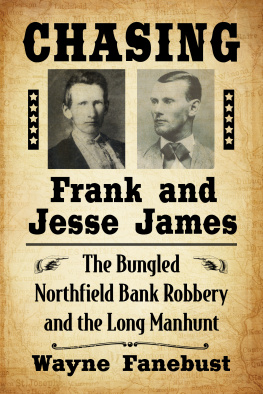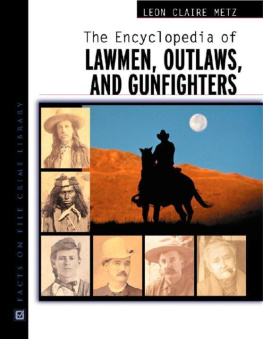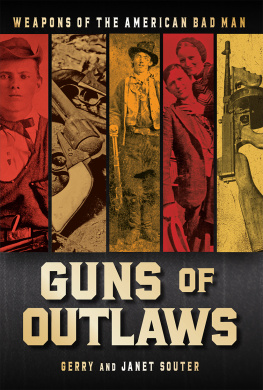Have you any idea of what a man must endure who leads such a life? No, you cannot. No one can unless he lives it for himself.
Frank James
we go aridin into town, a-whompin and a-whumpin every livin thing that moves within an inch of its life. Except the women folks, of course.
Slim Pickens, Blazing Saddles
GUNS OF OUTLAWS
WEAPONS OF THE AMERICAN BAD MAN
GERRY AND JANET SOUTER

First published in 2014 by Zenith Press, an imprint of Quarto Publishing Group USA Inc., 400 First Avenue North, Suite 400, Minneapolis, MN 55401 USA
2014 Quarto Publishing Group USA Inc.
Text and photographs 2014 Gerry and Janet Souter, except where noted otherwise
All rights reserved. With the exception of quoting brief passages for the purposes of review, no part of this publication may be reproduced without prior written permission from the Publisher.
The information in this book is true and complete to the best of our knowledge. All recommendations are made without any guarantee on the part of the author or Publisher, who also disclaims any liability incurred in connection with the use of this data or specific details.
We recognize, further, that some words, model names, and designations mentioned herein are the property of the trademark holder. We use them for identification purposes only. This is not an official publication.
Zenith Press titles are also available at discounts in bulk quantity for industrial or sales-promotional use. For details write to Special Sales Manager at Quarto Publishing Group USA Inc., 400 First Avenue North, Suite 400, Minneapolis, MN 55401 USA.
To find out more about our books, visit us online at www.zenithpress.com.
Digital edition: 978-1-62788-542-3
Hardcover edition: 978-0-76034-645-7
Library of Congress Cataloging-in-Publication Data
Souter, Gerry.
Guns of outlaws : weapons of the American bad man / Gerry and Janet Souter.
pages cm
Summary: A look at the weapons used by infamous outlaws throughout American history, featuring stories of their use, glimpses into the minds behind the trigger fingers, and over 200 historical images-- Provided by publisher.
ISBN 978-0-7603-4645-7 (hardback)
1. Outlaws--United States--History. 2. Firearms--United States--History. I. Souter, Janet, 1940- II. Title.
HV6446.S68 2014
364.1092273--dc23
2014017559
Acquisitions Editor: Elizabeth Demers
Project Manager: Madeleine Vasaly
Design Manager: James Kegley
Layout: Helena Shimizu
On the front cover (left to right):
Jesse James. Library of Congress; Pile
of Guns. Author photo; Billy the Kid.
Library of Congress; Clyde Barrow and
Bonnie Parker. Library of Congress;
Tommy gun. Dja65/Shutterstock
ACKNOWLEDGMENTS
The authors wish to thank the following for their assistance in writing this book:
Lynn Carson, of the Dalton Defenders Museum, Coffeyville, Kansas
Dale Chlouber of the Washington Irving Trail Museum
Dave Cooper, photographer, and Robert Rea, president, of the Franklin County Historic Preservation Society, Benton, Illinois
Jim Covell of the New Mexico Gun Collectors Association
Shelly Crittendon and Amanda Crowley of the Texas Rangers Hall of Fame and Museum, Waco, Texas
Peter Cutelli, of the St. Louis Weapon Collectors
Zac Distel and Kelly Williams of the Frazier History Museum in Louisville, Kentucky
Thomas Haggerty of the Bridgeman Art Library
Jessica Hayes and Jessica Hougen of the US Marshals Museum in Fort Smith, Arkansas
Laura Hoff, Laraine Daly Jones, Caitlin Lampman, and Rebekah Tabah of the Arizona Historical Society
Samuel Hoffman and Tom Pellegrene of the Journal Gazette in Fort Wayne, Indiana
Marguerite House of the Buffalo Bill Center of the West in Cody, Wyoming
Susan Jaffe and John Paul of Guernseys Auctions, New York
Lisa Keys and Nikaela Zimmerman of the Kansas Historical Society, Topeka, Kansas
Loren McLane of the Fort Smith National Historic Site in Fort Smith, Arkansas
Dale Peterson of the Minnesota Weapons Collectors Association
Silka Quintero of the Granger Collection
Michael Runge of the City of Deadwood Archives, Deadwood City, South Dakota, and also Rose Speirs and Carolyn Weber of the Adams Museum in Deadwood
Jason Schubert of the Davis Arms and Historical Museum, Claremore, Oklahoma
Hayes Scriven of the Northfield (Minnesota) History Collaborative
Elizabeth Van Bergen of Christies Auction House
Roy Young, editor of the Wild West History Association Journal
A special thank you to the following:
Kathie Bell of the Boot Hill Museum in Dodge City, Kansas, for the hours spent searching through the museums archives and the museum staff for taking the time to help us photograph the weapons in Boot Hills extensive collection. Also, the staff of Dodge Citys Long Branch Saloon for their help, advice, and Old West hospitality
Marguerite House of the Buffalo Bill Center in Cody, Wyoming, for her time and efforts in researching the museums database
Hans and Eva Kurth of the Cody Dug Up Guns Museum, Cody, Wyoming, for taking the time to help us photograph their unique collection
Patrick Quinn of Rock Island Auctions for his expertise, time, and encouragement providing digital images attributed to outlaws and lawmen
CONTENTS
INTRODUCTION
T HE DEADLY GUNS of the bandit trade tell the story of American outlaw culture. Those same guns blazed hot in the hands of the underpaid lawmen who doggedly pursued the American bad mans greed-fueled determination never to pay for what he could steal.
Six guns, rifles, shotguns, and pistols evolved into exotic weapons of murderous destruction, leaving a trail of artifacts that reaches far back into the violent history of the United States. Firearms evolution is not the tail that wagged the dog, but is instead the residue that marks the rise and fall of the outlaw trade from the eighteenth century to the 1940s, when the last of the legendary outlaws, Al Capone, Chicagos boss of bosses, left Alcatraz Prison and later died in his bed, a disease-ravaged, babbling shell of a man whose name had become a chilling synonym for lawlessness around the world.
Outlaws and the lawmen who pursued them came in all shapes and sizes, colors, and genders as did their implements of aggression and protection. In these pages well examine and discuss the actual guns they carried as well as lookalikes and trends in technology, all gathered from museums, historical societies, and private collections. The difference between owned by and used by is pursued as far as provenance permits. This is not a catalog. It is as much archeology as it is history. Like the swords of ancient kings, these artifacts bear the scuffs, rust, and scabbard-wear of use, or of the curious vanities of their ownersengravings, inlays, plating, and hand-carved notches commemorate survival, or the defeat of a rival who was two seconds too slow.
Well also explore life on the owlhoot trailan imaginary twisting outlaw pathand visit where outlaws lived, where they worked, and where they died. The mythology of their lives and skills is a dense thicket of hearsay, facts, fantasies, truths, delusions, and steaming heaps of once- or twice-digested lore that makes for great stories, but can be bottomless traps for the historian. For instance, there are many versions of the deaths of Billy the Kid, Butch Cassidy, and Pretty Boy Floydall sworn to in writing. The gunfight at the O.K. Corral is a virtual blizzard of half truths and misdirections, and at least one unique gun is widely described in great historical detail, but never actually existed.
Next page











